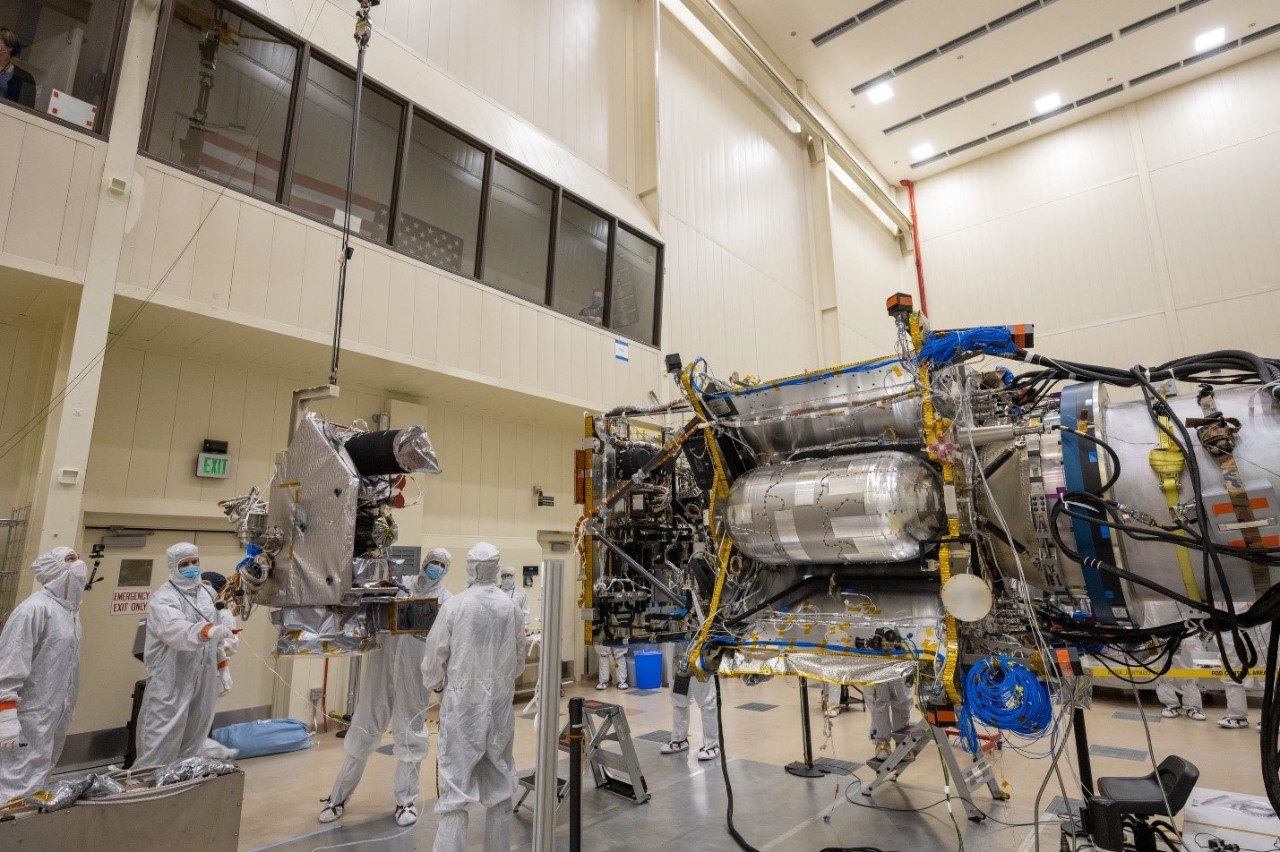Lockheed Martin Space designs, builds and tests spacecraft – and most people don’t realize: we fly them, too.
Ours is the only industry company offering that level of turn-key service. Our Mission Support Area (MSA) in Denver plays a central role in making it possible.
From 30 years of mission operations that have logged 1 million flight hours and counting, we take a look at our flight operations by the numbers.
Three Decades of Mission Operations
The MSA got its start in 1989 with Magellan, NASA’s first foray into Venus exploration. Lockheed Martin will again be involved in NASA’s grand return to Earth’s gaseous sister planet at the end of the decade.
The team built the Magellan orbiter in partnership with NASA’s Jet Propulsion Laboratory (JPL). Lockheed Martin then set up an extension of the JPL flight operations network at our Littleton, Colorado, facility to provide the voice, video and data infrastructure needed to fly the spacecraft around Venus.
And just like that, Lockheed Martin’s mission operations team was born.
Kyle Martin, now chief systems engineer for mission operations, had just joined Lockheed Martin in the summer of 1989 when a supervisor approached him and asked, “How would you like to help us out with the Magellan Venus orbiter? We just launched it.”
“I said, ‘Sure,’ went over there and never left,” Kyle recalls. He helped lead the effort to build out the MSA’s processes. “We had to develop everything – ‘How do you send commands to a spacecraft? How do you approve them?’ – and put together the processes that we still use today.”
15 Different Spacecraft, Three Types of Missions
In all, the MSA has flown 15 different Lockheed Martin-built missions for NASA. Those spacecraft have orbited the Moon, Mars, Jupiter and Venus, touched down on Mars, and collected samples from solar wind, a comet and an asteroid.
The missions fall into three main categories:
- Robotic orbiters and probes: The MSA has flown several robotic orbiters and probes since Magellan traveled to Venus, including the GRAIL (Gravity Recovery and Interior Laboratory, 2011) lunar orbiter and the Juno (2011) mission to Jupiter. The trip to Mars has become a familiar one for the MSA, starting with the Mars Global Surveyor (MGS) in 1996. Other missions include Odyssey (2001), Mars Reconnaissance Orbiter (MRO, 2006) and MAVEN (Mars Atmosphere and Volatile Evolution, 2013).
- Landers: The MSA has also guided landers to the Martian surface. Phoenix touched down in 2008 and InSight, short for Interior Exploration using Seismic Investigations, Geodesy and Heat Transport, returned to the Red Planet in 2018. It’s Lockheed Martin’s 21st Mars mission and 11th Mars spacecraft.
- Sample return spacecraft: The MSA also has flown every one of NASA’s sample return missions since Apollo. Genesis (2004) collected solar wind particles. Stardust (1999) captured bits of comet dust. The latest mission, OSIRIS-REx (Origins, Spectral Interpretation, Resource Identification, Security-Regolith Explorer) launched in 2016 and will return asteroid regolith to Earth in 2023.

The MSA team is lean, with about 70 members working on multiple missions.
“It’s common to find somebody that works on two, if not three or more, of our flying missions,” Sandy explains, “because we keep all of our procedures and processes consistent across missions. That makes it easier for us to add staff if a program is coming up for a big event like an orbit insertion.”
The teams include “aces” – the engineers who send commands through the DSN – as well as systems engineers, test engineers and subsystems engineers.
They do things like:
- Support in-flight maneuvers, testing and conduct special scientific research requests
- Monitor data to analyze general spacecraft health and evaluate trends
- Share data through the worldwide Deep Space Network (DSN) antennas
- Develop and validate commands to operate spacecraft
- Create background sequences and other routine functions that allow spacecraft to transmit data back to Earth
- Redesign mission capabilities to extend science collection
MSA team members are involved in every phase of a mission. “What we do is unique,” Kyle says. “As soon as the mission contract is funded, we have our mission operations people involved at the very beginning with design. We’re testing like we’re flying.”
“Then, we take all that knowledge we gain through design, development and testing back to the MSA where we fly the spacecraft all the way to the mission end,” he remarks.
Six Missions in Flight Now
In June 2021, the MSA marked an incredible 1 million hours of flight time.
With six missions still flying, that number will only continue to rise. The MSA currently runs mission operations for InSight, MRO, Odyssey, Juno, MAVEN and OSIRIS-REx. All except OSIRIS-REx have surpassed their original mission lifespan, and that’s just because it hasn’t returned its asteroid sample to Earth yet.
Like the spacecraft they fly, the MSA teams can handle even the most complex missions.
Our engineers developed and carried out delicate proximity operations for OSIRIS-REx as it orbited the tiny asteroid Bennu. It was the first time anyone has ever operated a spacecraft so close to a small celestial body and in a microgravity environment. When OSIRIS-REx’s special TAGSAM (Touch and Go Sample Acquisition Mechanism) collection mechanism made contact with the asteroid Bennu to collect a sample, the MSA team was at the controls.
The MSA also handles shifting demands of extended-mode missions. The ability to adapt to their changing science and orbital requirements shows the MSA’s versatility, says Sandy Freund, mission operations manager.
“A lot of these missions fly much longer than anyone anticipates during the design phase,” she explains. “We might have to adjust to a new orbit that we hadn’t analyzed before or figure out how to work within the constraints of the spacecraft to meet the science team’s needs.”
Four Missions Ahead

And the excitement keeps growing, with four new MSA missions launching in the next several years.
First is the Lucy mission, with a launch window opening Oct. 16. The MSA will guide Lucy on its 12-year, 4-billion-mile odyssey to Jupiter’s Trojan asteroids –the first spacecraft to explore those “fossils” of the solar system.
Next up is Janus, a pair of small satellites that will study two binary asteroids. One of NASA's Small Innovative Mission for Planetary Exploration (SIMPLEx) finalists, Janus will launch in 2022 to reach the asteroid system in 2026.
Also ahead are the newly awarded VERITAS and DAVINCI missions for NASA’s Discovery Program, set for launch in the 2028-30 timeframe. Both missions will aim to discover how Venus – which may have been the first potentially habitable planet in our solar system – became inhospitable to life.
New Network for Future Missions
Starting with Lucy, our Ground Data Systems (GDS) team will pioneer an integrated ground services infrastructure dubbed MONET, or Mission Operations Network. Development of the system began back in 2018.
“MONET will provide integrated voice, video, and data infrastructure to support multi-mission development, test and flight operations. The architecture consists of the core MONET infrastructure, plus mission specific zones for external partner interfaces and unique needs,” says Lance Tanaka, Ground Data Systems manager for the MSA.
The new infrastructure will allow efficient “As-A-Service” capabilities for users while enabling future, standalone mission operations services like mission planning, science processing or navigation. “Plus, having this infrastructure also allows us to more easily integrate our digital transformation tools for things like data analytics or spacecraft monitoring and control,” remarks Lance.
As the Lockheed Martin mission operations team prepares to add even more transformative technologies and spacecraft to its line-up, the team looks forward to all those missions will discover – one command at a time.




